
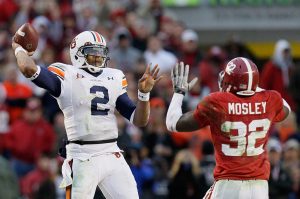 Welcome to Season Two of Tiny Expeditions. This season will take you on little journeys into the tiny science of agriculture. We will venture through a peanut field to learn how science could save your favorite candy bar, make a stop in a local craft brewery to learn how genetics is improving yeast, hops, and barley to make a better craft beer, and many other interesting trips.
Welcome to Season Two of Tiny Expeditions. This season will take you on little journeys into the tiny science of agriculture. We will venture through a peanut field to learn how science could save your favorite candy bar, make a stop in a local craft brewery to learn how genetics is improving yeast, hops, and barley to make a better craft beer, and many other interesting trips.
But first, we are digging into a football rivalry gone bad and the science that emerged as the victor. The year was 2010 and it was a typical fall football season in the south. The University of Alabama and Auburn University football teams were geared up, ready to go face-to-face in the annual Iron Bowl game at Bryant-Denny Stadium in Tuscaloosa.
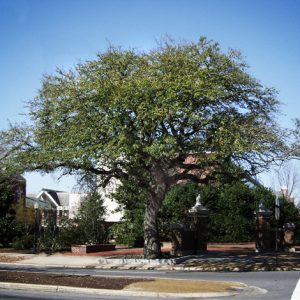 After a dominant Alabama start, Auburn was down 24-0 in the second quarter of the game. Through grit, determination, and a little luck, Auburn would come back to win 28-27. Alabama fans were disappointed and upset that their boys blew a double-digit lead and lost such a big rivalry game at their home stadium.
After a dominant Alabama start, Auburn was down 24-0 in the second quarter of the game. Through grit, determination, and a little luck, Auburn would come back to win 28-27. Alabama fans were disappointed and upset that their boys blew a double-digit lead and lost such a big rivalry game at their home stadium.
One Alabama fan in particular took his anger to an extreme level and poisoned the iconic Toomer’s Oak trees just weeks after the Iron Bowl loss. In our first journey this season, we met up with two researchers that are helping to turn this arboreal tragedy into a scientific victory.
Listen to Tiny Expeditions Season 2, Episode 1: Will Science Emerge as the Real Champion in a Football Rivalry Gone Bad? to learn the fate of the poisoned trees and how they inspired a project to increase equity in scientific education.
Behind the Scenes
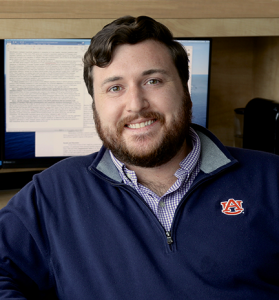
The Toomer’s Oak tree genome project begins at HudsonAlpha where long fragments of DNA are extracted from leaf tissue and read with high accuracy on cutting-edge sequencing machines. This is Dr. Alex Harkess who is leading the efforts of the sequencing at HudsonAlpha.
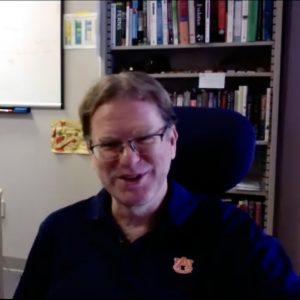
The raw data from the sequencers travels back to Auburn’s campus where the job of assembly, requiring complex algorithms and massively parallel computation, is being performed on Auburn’s Hopper Supercomputer. This is a photo of Dr. Les Goertzen who wrote the Tiger Giving Day proposal with Dr. Harkess and teaches the Toomer’s Oak tree genome course at Auburn.
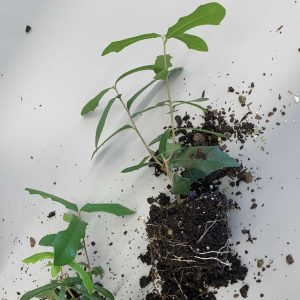
On the day we visited Dr. Harkess’ lab we got an exciting surprise—lab manager Haley Hale was preparing the Toomer’s Oak leaf samples for sequencing. Before the samples are ready to be sequenced, Haley has to physically crush the leaves to break the cell walls and release the contents from within the cells. Then she uses a chemical to disrupt the cell membranes and release the DNA from inside. The photo on the left shows some of the Toomer’s Oak clones from which the team extracted DNA. The tube in the photo on the right contains the extracted DNA in a liquid called a buffer.
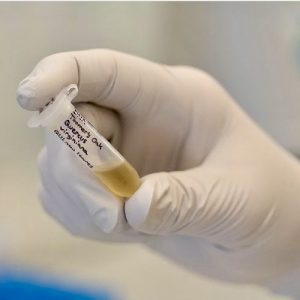
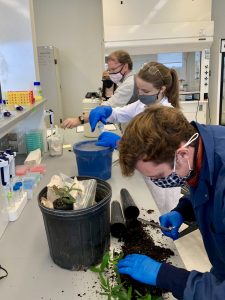
The picture to the left really sums up the collaborative nature of the project! Dr. Goertzen drove eight Toomer’s Oak clones (pictured right) all the way from Auburn’s campus to HudsonAlpha’s campus in Huntsville, Alabama. He stayed to help Dr. Harkess and his team collect samples from the clones. Some of the samples will be used fresh for DNA and RNA extractions. Other samples collected from the leaves, roots, and branches can be used to study nutrient requirements, pathogen resistance or susceptibility, and other traits of the oak tree.
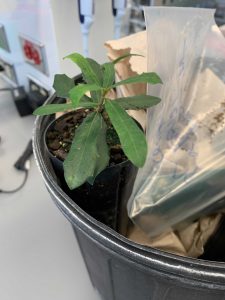

Co-hosts Chris Powell and Dr. Sarah Sharman talking with Dr. Les Goertzen over Zoom.
Sarah Sharman 0:00
Welcome to Season Two of Tiny Expeditions, a podcast about genetics, DNA, and inheritance from the HudsonAlpha Institute for Biotechnology. This season is all about the science of plants and agriculture.
Chris Powell 0:13
I’m your co-host and storyteller Chris Powell.
Sarah Sharman 0:15
And I’m your co-host and science advisor Dr. Sarah Sharman.
Chris Powell 0:19
Before we get into today’s episode, we want you to be aware that portions of this podcast were recorded in binaural audio meaning there may be times where it sounds like something, or someone is behind you or to the side of you. Don’t worry, we planned it this way to take you on the journey with us and to experience this in its fullest. We advise you to wear headphones or use surround sound speakers, but if you don’t have those available, don’t worry, you’ll still have a great experience. Let’s get into today’s episode. Most children who grew up in Alabama will be asked one simple question when they start school.
Children’s voices 0:57
Who do you go for?
Sarah Sharman 0:58
And there are only two acceptable answers.
Children’s voices 1:01
Auburn War Eagle! Alabama Roll Tide!
Chris Powell 1:09
Here in the south, we take our college football traditions very seriously.
Sarah Sharman 1:15
From the midnight yell at Texas A&M to the Rammer Jammer chant after a win at the University of Alabama to the ring of the cowbells at Mississippi State University.
Chris Powell 1:32
One of the most iconic traditions that has happened on celebratory nights for decades is the rolling of Toomer’s Corner at Auburn University. After an Auburn victory, students stormed the corner of College Street and Magnolia Avenue in downtown Auburn. This is also known as Toomer’s Corner. They throw toilet paper over the two live oak trees that reside there.
Sarah Sharman 1:55
It is thought that this tradition began because employees of Toomer’s Pharmacy would let students know that the Tigers football team had won an away game by taking their telegraph ticker tape and throwing it over the power lines. In 2010, Auburn and their cross-state rival Alabama both had national championship aspirations.
Auburn Football Sports Announcer 2:14
Hello again everybody and War Eagle. I’m Rod Bramblett with Stan White and Quintin Riggins at Bryant Denny Stadium where over 100,000 have gathered the largest crowd ever to watch Auburn and Alabama play football.
Chris Powell 2:26
Alabama came into the game ranked 11th in the country while Auburn was ranked second and brought with them an undefeated season to that point. The Tigers were energized by Cam Newton and had their eyes set on the national championship. But all of that looked to be in jeopardy as Auburn trailed Alabama 24-0 in the first half. In the second half, Cam Newton led a comeback and the Tigers ultimately won 28-27. In the south, though, the storylines of games like this rarely end when the final whistle blows.
Sarah Sharman 3:04
Unfortunately, the two iconic live oak trees that had lived on Toomer’s Corner since 1937 got caught in the crosshairs of that loss when they were poisoned by an angry Alabama football fan.
Alex Harkess 3:16
And these trees were poisoned in such an intense way that there was no way to save them.
Sarah Sharman 3:21
And that’s the voice of Dr. Alex Harkess, an evolutionary biologist who is a joint faculty member at Auburn University and the HudsonAlpha Institute for Biotechnology.
Alex Harkess 3:31
Even though professors tried, they tried to replace all the soil. This herbicide that was used tebuthiuron, or spike 40, is very powerful.
Les Goertzen 3:41
It’s hard to describe what people were feeling and going through back at that time.
Chris Powell 3:46
That’s the voice of Dr. Les Goertzen, an Auburn Assistant Professor in the Department of Biological Sciences. Dr. Goertzen is an evolutionary geneticist, and he was on campus during the time of the Toomer’s Oak poisoning.
Les Goertzen 3:59
Our entire campus was just a mess. It was an extremely emotional event, but still, one that had so much significance and was such a sort of senseless kind of crime or incident as well. You know, it was a lot to go through. People were really looking for a way to try to respond constructively. We had colleagues and in fact, really the community on the University of Alabama campus was also incredibly supportive in raising funds to save the trees and things like that as well. So, there’s a lot of outpouring of goodwill people trying to find a way to respond kind of positively.
Sarah Sharman 4:38
But all of this goodwill can only take you so far with trees that are about to die. Leaders at Auburn and across the state had to quickly decide how they were going to try to save or memorialize the trees.
Alex Harkess 4:51
Before the Toomer’s Oak trees died, not many people know this actually, a few professors from the Department of Horticulture, as well as the College of Science and Math, took clonal suckers off of the tree.
Les Goertzen 5:02
Within just a week or so of the incident, everyone on the science side realized from what those trees got hit with, we knew we were going to lose them. There was just no coming back from that. And so Gary Keever, who was the guy who was really responsible for the collection of cuttings and the efforts to save the tree and things like that in those days, he had asked us to come out there to help out with that kind of cutting situation and make some herbarium vouchers for the museum, like actual specimens of those trees so that were also vouchered as a museum specimen another sort of tribute to the trees. And at that time, you know, I grabbed a couple of Ziploc bags full of leaves that were still more or less fresh on the tree and put them straight into the -80 [freezer] just for the posterity for the eventualities that we might be able to do something with them.
Chris Powell 6:00
Dr. Goertzen and team had the foresight to not only take samples and freeze them for later study, but they also took clippings of the tree to create exact clonal representations of the Toomer’s Oaks. Scientists call these clonal suckers.
Les Goertzen 6:15
These are the actual physical pieces of the tree that were induced into rooting, and then regrown in pots and replanted out into literally perfect copies of the original tree.
Sarah Sharman 6:27
The original frozen samples collected in 2013 are limited in number. So having these identical clones of the original Toomer’s Oaks is important for the longevity of biological projects on the trees. In addition, live tissue is better for some experiments, because freezing and thawing can damage cells.
Les Goertzen 6:46
We want all the fresh live cells, and we want the various and diverse tissues as well for various aspects of say the genome annotation, that type of thing.
Chris Powell 6:56
So, the question still remains, how do you memorialize a tree that means so much to so many people? Well, as it turns out, the answer to that question is in the tree itself, in its DNA,
Les Goertzen 7:07
We thought something like a genome project, which is a very lasting and a very sort of high honor and a way to make these trees the representatives of their species, that was going to enshrine them basically forever in the annals of science.
Chris Powell 7:21
With the samples that Dr. Goertzen and his team took from the Toomer’s Oaks, they were able to get those samples to Dr. Harkess and sequence them to put together what is known as a reference genome. Dr. Sharman, can you share a little more light on what a reference genome is? And why is this important?
Sarah Sharman 7:38
A reference genome is a representative example of a set of DNA sequences for a species. They’re important because they serve as a template for scientists when they’re sequencing other members of the same species. So, in the case of our oak trees, the Toomer’s Oak tree genome will be used as a guide for assembling the sequences of any live oaks that are sequenced after it. Basically, the scientists are piecing together a puzzle and the reference genome is the picture telling you where each piece goes. Reference genomes also serve as a point of comparison when scientists are looking for disease or trait causing changes in DNA. Scientists can compare the DNA of an organism to the reference genome to find these changes in the DNA sequence.
Chris Powell 8:20
So, because of the reference genome, the impact of the Toomer’s Oaks will live on well past them and will help give us insight into oaks themselves and oaks are incredibly important.
Alex Harkess 8:32
Three things come to mind when I think of the power and the importance of oaks as an entire genus. Those three things are life and their ability to support life, their ability to sequester carbon, and their ability to control water.
There are almost 600 species of oak trees, and roughly a third of them are endangered. And the reason this matters so much is oaks in many ways have this incredible conductivity, meaning that they support so much of the food web, they are called keystone species. A keystone species is something that if you remove it, kind of like the keystone of an arch, the whole system collapses. 84% of counties in the United States have an oak as the number one plant keystone species. And remember, 1/3 of those 600 oak species across the planet are currently endangered. So, oaks are not just iconic campus treasures. They are integral parts of the ecosystem services and the food web that drives diversity and several other things that are important to how biodiversity functions.
Oaks are incredible at carbon sequestration, meaning that oaks have huge canopies, huge trees often and huge roots stems. And if you have a lot of leaves, what you’re able to do is suck carbon dioxide out of the atmosphere and store it either in your body as a tree or in the soil or in the roots surrounding it. In other words, oaks are one of our most powerful ways on our planet of storing carbon in the soil. Oak trees obviously have huge root systems, some of the biggest out of any of the tree systems on the planet today. So, what they’re able to do is, one stabilize the ground, two absorb a massive amount of water, and three, since they have these huge canopies, they’re often able to buffer or protect the ground underneath. In other words, oaks act as this almost like sponge that keeps water where it falls.
Sarah Sharman 10:47
During their lifetime, the Toomer’s Oaks brought together the Auburn campus and were viewed as much more than just trees. Their genome is now being memorialized and will forever contribute to the scientific community. Now, Dr. Goertzen and Dr. Harkess have found a way to use this research to give back to the Auburn students too.
Alex Harkess 11:06
Trees, like oaks, harbor amazing amounts of biodiversity they bring together ecosystems, they are the keystone species, and without them, those ecosystems often fail. So why can’t students also be part of those diverse ecosystems? And not just students, a diverse group of students that otherwise wouldn’t necessarily have had an opportunity like this, to work on a complex plant genome and develop their skills as an author on a paper.
Les Goertzen 11:36
There are a lot of spin-off possibilities that are already afoot. We are turning this into actual courses here at Auburn that graduate students are benefiting from and learning from it so that the educational spin-offs are happening.
Alex Harkess 11:50
I remember meeting a student at a conference about four years ago. And I asked her, ‘What do you think was the most important part of you landing your dream school for a PhD?’ And she said, ‘Oh, that’s easy. I had published papers as an undergraduate.’ And then it all clicked with me that even though we got rid of the GRE, we just changed the barriers for students to enter. And it’s still difficult and not equitable in many ways. The students who are able to work in laboratories are often working in laboratories for little or no money, like for credit, for instance. And the students who are unable to do that need to work elsewhere in other places on campus to actually make money. And so, there’s a certain amount of privilege that’s baked into the way that we select for scientists for PhD and master’s programs. And I wanted to change that in a small way that I thought was tangible. What we think is a potential solution to raising equity in the field of genomics has been right on our campuses this whole time.
Chris Powell 13:09
Dr. Harkess and Dr. Goertzen are reducing the barriers that keep students from attaining their goals as a scientist, primarily publishing manuscripts. Not only are they allowing students a way to be published, but they are also giving them access to technology in the lab that many universities simply don’t have access to. Let’s take a moment and follow Dr. Harkess into the lab to see exactly what’s going on behind the scenes.
Alex Harkess 13:20
We have to badge in first. We’re headed to the HudsonAlpha Genome Sequencing Center. And all along this set of corridors, you’ll find three or four laboratories that are exclusively focused on the genomics of plants. There’s my laboratory, there’s Dr. Josh Clevenger’s laboratory, Dr. Jane Grimwood’s laboratory, and Jeremy Schmutz’s laboratory.
Chris Powell 13:48
So as we’re walking, though, there’s a ton of pictures here are these all plants that you work with?
Alex Harkess 13:56
These are all plants that have been sequenced and assembled here at HudsonAlpha. And this place is very special, actually. For a long time, we’ve avoided sequencing genomes of complex plants, because it’s so difficult and so expensive. But since HudsonAlpha has this historic expertise working on things like the human genome project that was published in 2001, now they’ve taken all that institutional knowledge and put it towards plants. And now in this building, more plant genomes have been sequenced and assembled than anywhere else in the world.
This is a PacBio Sequel II sequencer. This allows us to take DNA, huge pieces of DNA and put it on these machines to sequence the ATCG nucleotides that make up that DNA. In other words, we use machines like this, and we have a lot of them, as you can see, to sequence the genomes of complex plants.
Chris Powell 14:56
So, in each of the machines we’re looking at right now DNA is being sequenced in each of these?
Alex Harkess 15:02
On each of these machines right now, which are pretty much constantly running, we are sequencing different plant genomes almost all the time.
Sarah Sharman 15:11
The sequencing equipment that we just saw in the lab is very expensive and financially out of reach for many institutions. One of the reasons that this project took a decade to come to fruition was lack of funding. Even though they had developed this amazing project, Dr. Harkess and Dr. Goertzen still had to figure out a way to pay for it.
Alex Harkess 15:30
Generating data like this costs money, though. And so, Dr. Les Goertzen and I were kind of in a conundrum. We needed to raise maybe $11,000 or $12,000, just to generate the raw data to put this Toomer’s Oak genome together as part of this course. So right around this time that Dr. Goertzen and I were talking, every year Auburn has the crowdsource fundraising event called Tiger Giving Day. And every college gets to submit a proposal that ends up in this Tiger Giving Day. And they’re well-advertised by the college. The idea is that they are for projects that are just necessary for some sort of student experience or elevating a club or a group or providing new kinds of opportunities for students on campus.
So, Dr. Goertzen and I wrote a proposal for decoding the Auburn Toomer’s Oak genome. And within a 24-hour period that Tiger Giving Day was live, we raised almost $12,000, from all the community. Alumni, students, staff, faculty, and even people not associated with Auburn were contributing money to this project. And it made me incredibly hopeful for the future of how we teach plant genomics because people realized, I hope, that it’s not just about a tree. It’s about building a set of diverse experiences with diverse students to make a tree more than just a tree.
Sarah Sharman 17:04
While this project is wrapping up its first semester at Auburn this fall, Dr. Harkess and Dr. Goertzen have their sights set on more campuses and more trees than just the Auburn oaks.
Les Goertzen 17:15
There’s almost always a tree at every major university that has this kind of reputation or history or significance culturally to the campus. They’re very often oak trees and they’re very often live oaks in the southeast. It’s amazing how many campuses like Texas A&M, Clemson, or Hampton University all have some famous massive live oak tree that’s of significance just to that campus. And so really what we’re doing is immediately translatable, it could be mirrored at these other universities. We’re building the framework for how to do something like this, all the way from the crowdsource funding of the alums and other interested parties, through to the educational products to the actual science itself. And then once you get a second tree down at a second place, you immediately got a point of comparison to, for example, the Toomer’s oak.
We’re looking to work with some people at Hampton University in Virginia, who have an incredibly significant, culturally important tree called the Emancipation Oak on their campus. It’s a massive multi-hundred-year-old live oak tree. And this tree marks the spot where the Emancipation Proclamation was read for the first time in the south. So, it has incredible significance and importance. And it’s a massive live oak, the same species as the Toomer’s Oak. And so doing our project there would have this really interesting point of view and have this point of comparison right off the bat.
Alex Harkess 18:43
So Dr. Goertzen and I just recently launched ACTG, or the American Campus Tree Genomes Project, where we’re trying to wrap up this idea of teaching a build it yourself and publish it plant genome course, that we’re developing right now at Auburn. But we want to be able to extend that to campuses across the country. And the idea is that if you on your campus want to do exactly what we’re doing at Auburn- you want your students to assemble and annotate and publish your campus’s famous or historic or important tree genome- my laboratory here at HudsonAlpha can help you generate that kind of data. And together with Dr. Goertzen, we can deliver you a set of modules, lectures, lessons, and laboratories and help you connect to this exact same compute virtual system that we’re using. So that you too, could do this exact same project with your tree on campus. It is just a tree to some people. But for everyone at Auburn, it meant more than that.
Sarah Sharman 19:55
Thank you for joining us on this tiny expedition into a football rivalry gone bad, and the science that emerged as the champion.
Chris Powell 20:03
This season we will continue journeying through the world of agriculture. We will trek through a peanut field, get a behind-the-scenes look at craft brewing, and see how technology is benefiting farmers and consumers alike.
Sarah Sharman 20:15
Tiny Expeditions is a podcast about genetics, DNA, and inheritance from the HudsonAlpha Institute for Biotechnology. We’re a nonprofit research institution in Huntsville, Alabama.
Chris Powell 20:26
We’ve got a campus full of scientists doing public research alongside companies developing products and services, all with one aim to translate genomic discoveries into real-world applications that make for a healthier, more sustainable world. That’s everything from cancer research to agriculture, for changing climate.
Sarah Sharman 20:44
If you find this work worthwhile, do us a small favor right now. Leave us a review on iTunes or wherever you’re listening to this and tell someone that you listened to this interesting little story about genetics. Help them find our podcast. Knowledge is better when you share it.
Chris Powell 21:01
We want to say thank you to the Auburn Sports Network for providing us with audio clips to use in this episode. And we want to say a special thank you to you for joining us and downloading this episode. We’d love for you to subscribe and join us every other week for our next tiny expedition.
Bonus Content
Due to time constraints, we were only able to share a small part of our journey into the lab with Dr. Harkess during Episode 1.
But you’re in luck! We are sharing the full lab tour with you here as a bonus.
Listen in as Dr. Harkess tours us through the amazing lab space that the HudsonAlpha Center for Plant Science and Sustainable Agriculture team is proud to call home.
Reminder: the audio you are about to listen to was recorded using 3D audio. To have the best experience, we recommend listening with headphones. It will sound like you are in the room with us, so don’t be surprised if you hear things all around you. Please take caution when listening while driving or operating machinery, we don’t want to cause any wrecks or accidents.
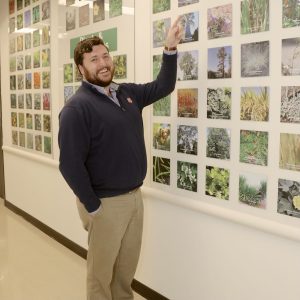
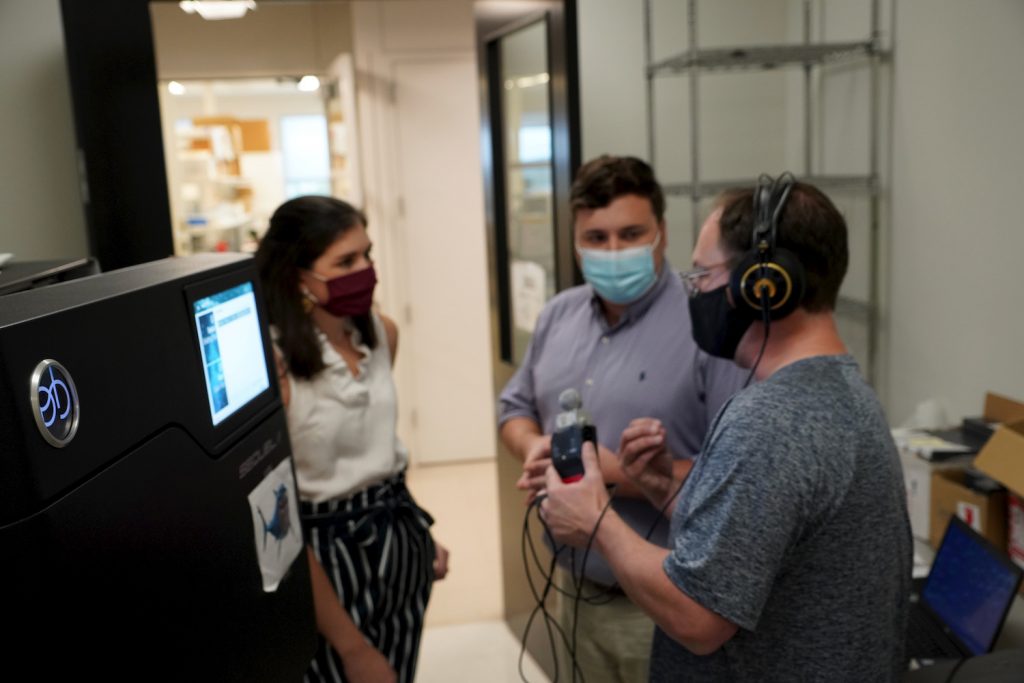
Chris, Dr. Harkess, and Sarah in the Genome Sequencing Center sequencer room.
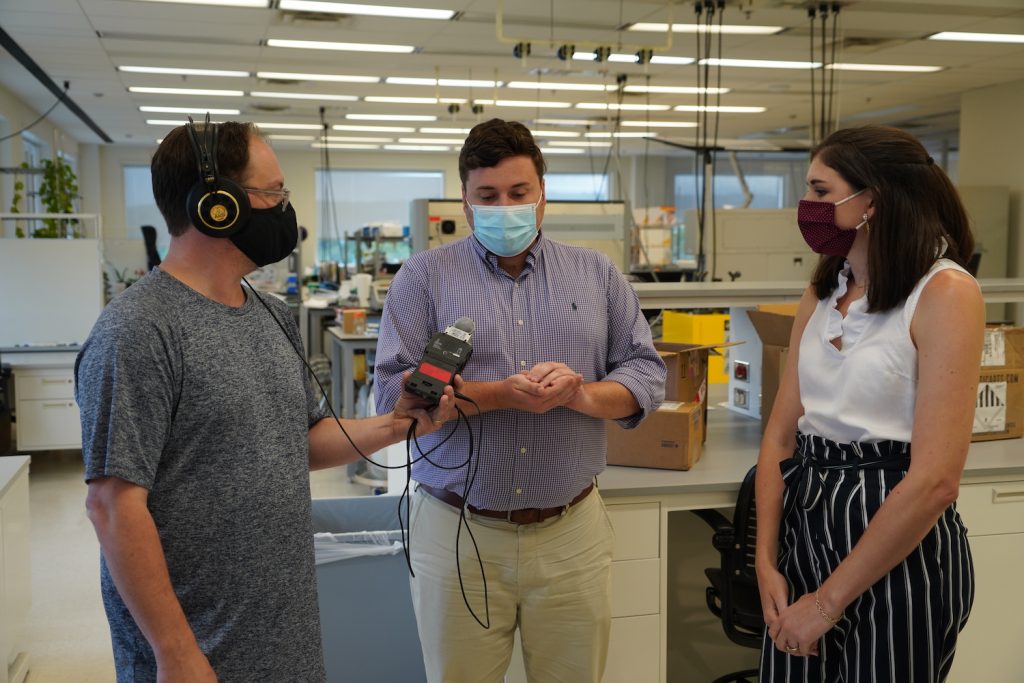
Chris, Dr. Harkess, and Sarah in the Harkess lab






